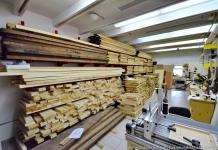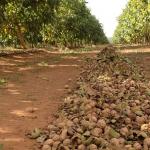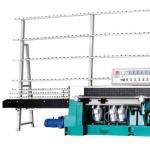Growing a walnut as a business is an opportunity to start your own business from scratch. Despite some pitfalls, the opportunity to make good money in the walnut business is very real. Nuts are a product that is well stored, is in great demand and is quickly sold.
- How to start a walnut growing business?
- How much can you earn growing nuts?
- How much money do you need to start a business?
- Disadvantages of growing nuts
- How to start a walnut business
- How much can you earn growing walnuts
- How much money do you need to start a walnut growing business

How to start a walnut growing business?
Any agricultural business begins with the acquisition of land. In Ukraine, you can try to get the free 2 hectares from the state. In Russia, large families have the right to a free plot of land.
In reality, it is quite difficult to realize one's rights to land. Therefore, the easiest option is to rent the necessary land.
To create a walnut grove, you can purchase seedlings. But the cheapest option is growing nuts from fruits.
When choosing varieties, you should not save. Wild nuts, although they will give good harvests for 100-200 years, but the fruits will not be of the best quality. Nuts will be small in size with a very hard shell. The kernels are poorly separated from the shells.
Growing walnut trees practically does not require additional costs. And care for an adult walnut grove is minimal. It is only necessary from time to time to apply organic fertilizers under the roots of trees, since nuts have a developed root system. The roots intensively draw all useful substances from the soil.
No weeding of seedlings, aisles of adult trees is required. Nuts release toxic substances into the soil. Not even weeds grow near them.
Walnut grove begins to bear fruit already in the fifth year of growth. But impressive harvests, which give tangible profits, can only be obtained after 10-15 years.

How much can you earn growing nuts?
Business on a walnut is a profitable business. Already in the 5th-7th year of tree growth, a yield of about 2.5 centners per hectare is obtained. Mature trees give about 40 centners. 20 years after planting, it is realistic to get yields of 50 centners per hectare.
In total, nut kernels come out about 20 centners. Given that a kilogram of nuts now costs 5-8 US dollars, the net profit per hectare is from 10 to 16 thousand US dollars per hectare.
Even if the site has a minimum of 2 hectares, the net profit for the season is up to 32 thousand dollars. Additionally, there will still be a small profit for the shell.
But in the first years of fruiting nuts, it will be necessary to make small expenses for the construction of a storage facility for fruits and the transportation of the crop. And yet, all costs pay off with interest over the next 30 years. Net profit for this period averages 400-950 thousand US dollars.

How much money do you need to start a business?
A walnut business, even for people with a small initial capital, is a promising business.
- Small cost of renting land.
- Small cost for the plants themselves. For one seedling you will have to spend no more than 2.5%. In total, no more than 420 seedlings will be needed for planting per hectare. The total costs for them are about 1050 US dollars per hectare. If you grow a grove of fruits, even a penny will be spent.
- Landing care costs are minimal. At the same time, the nuts grow well.
- Products are always in demand not only in our country, but also abroad. The market is always there.
- The harvested crop can be stored for a long time. All you need is a well-ventilated storage room. The fruits withstand severe frosts, the quality does not fall.
- Walnut is a relatively new promising occupation in business in subsequent years.
- There are practically no competitors, since the walnut business is underdeveloped in our country.
Disadvantages of growing nuts
The disadvantages of growing nuts include some cost at the initial stages of fruiting. People with a small income will have to carry out many works on their own at first. In addition, you will have to spend the first profit on the construction of a storage facility for fruits, transporting the crop.
But in the future, all expenses are paid off. You can hire hired workers to service the business.
The walnut business is a very promising business. Although the profit does not come immediately and it takes several years to wait for a good harvest, a steady solid income is ensured in the future.
Having taken up the walnut business, in subsequent years you can fully provide for your family. Yes, and for old age there is a good penny. Also a real prospect is the expansion of its activities. Fortunately, enough experience has already accumulated.
How to start a walnut business
To start a business, you need to determine its scale, if the entrepreneur plans to use a plot of land less than a hectare, then registration is not needed, this is a personal subsidiary plot. For an area of more than one hectare, it is worth issuing an IP, since this is already considered a form of entrepreneurship. Next, it is worth choosing a plot of land for planting, with an area of at least 50 acres. The walnut tree begins to bear fruit after 4-5 years, so a long-term lease or purchase of land is needed.
Walnut is not a whimsical plant, it does not require special conditions or climate to grow. When buying seedlings, it is worth paying attention to their quality and the elite variety, in the future this will affect productivity and profitability. Before planting, the ground must be fertilized with mineral or organic fertilizers; after the seedling is strengthened in the soil, further care is practically not needed. Further, only systematic watering and protection of the tree from diseases and pests is necessary.
It is necessary to take care of the distribution channels for finished products in advance. It is recommended to conclude an agreement with a confectionery factory or a bakery, since walnuts are used in the cosmetic and medicinal industry, you can start cooperating with pharmaceutical companies.
How much can you earn growing walnuts
The profitability of a business depends on the area of the garden, the number of trees in it and their yield. On average, 160-200 trees can be grown on one hectare of land, 17-25 kilograms of fruits are harvested from one nut, the price per kilogram of peeled nut leaves 250-300 rubles. Having calculated, we can conclude - from one tree, with a normal yield, you can earn 6,000 - 7,000 rubles per season, and from 200 trees - 1,200,000 rubles, respectively.
How much money do you need to start a walnut growing business
The main list of investments in the cultivation of walnuts (per 1 hectare of land):
Preparation of a plot of land for planting (plowing, cultivation) 50,000 rubles;
Purchase of seedlings 130,000 - 150,000 rubles;
Preparation of landing pits and landing 60,000 - 80,000 rubles;
The cost of maintaining the garden is 100,000 rubles per year.
Given that walnuts begin to bear fruit after 5 years, we can conclude that starting a business will require about 700,000 - 800,000 rubles per hectare of land planted with walnuts.
This fruit has long been famous for a whole range of vitamins and nutrients. Today there are many varieties of nuts. They have their own characteristics, taste, different yield indicators.
We suggest that you familiarize yourself with the varieties that are best suited for growing in the country.
"Aurora"
The plant tolerates winter well, grows quite actively. The core of the fruit has a mass of 8-10 g. The shell is thin, breaks well.
"Memory of Minov"
The fruits of this variety are quite large, the tree grows rapidly. Fruiting occurs according to the apical type. The first crop begins to appear 5-6 years after planting. It has resistance to brown spotting.
Nuts are large, flattened. Core weight - 15 g.
At the end of September, you can start harvesting. 
"Carpathian"
The variety has a high, stable yield, is relatively resistant to marsonia. The plant stands out with a large rounded crown. The formation of fruits occurs on the apical buds.
Fruits of medium size - from 11 to 13 g of a round shape. The yield of a tree is about 70 kg.
"Harvest"
The variety is represented by a rather tall tree - up to 6 m. It has a wide, oval crown. The first fruits appear three years after planting. The variety belongs to the group of mid-season, and it is recommended to harvest at the end of September.
Ecology of life. One of the main advantages of this direction is that the demand for this useful product is growing every year, but there are not so many businessmen who are engaged in growing on an industrial scale. Why?
One of the main advantages of this direction is that the demand for this useful product is growing every year, but there are not so many businessmen who are engaged in growing on an industrial scale. Why? Firstly, this is a purely seasonal business, many are not ready to wait and hope that there will be a harvest and that the profit will meet expectations. Secondly, the lack of landing areas.
What are the benefits of walnuts? They have long been recognized as the most useful product on earth. They have a positive effect on the functioning of the brain, and the human body as a whole. Even scientists recommend eating a dozen of these fruits every day, and then you are not afraid of any diseases. Such a nut in its composition contains iodine and many useful trace elements: proteins, fats and vitamin E.
Also, this line of business is one of the few that can be attributed to a passive type of income. So having planted trees once, you will be able to harvest fruits for many years. They do not require special care and take root perfectly on the territory of Ukraine, Russia and Belarus.
The largest producer of walnuts is the United States, as well as some European countries.
One of the main markets for nuts is the medical industry. Various medicinal tinctures are made from them.
How to choose a variety of walnuts?
It's no secret that by choosing the right varieties of these fruits, you can not only get good yields, but also build a ripening structure for different seasons. So one of the most popular varieties of walnuts is "Ideal". This variety is not in vain bears such a name, he received it due to its characteristics. So it has a thin shell, and the average weight of the kernel is about 10 grams. A 20 year old tree can produce 120 kg of fruit annually. Usually this variety starts, brings a harvest after 3 years after planting. Experienced entrepreneurs buy this type of trees as early as the age of five in order to quickly reach a high yield level.
"Ideal" is great for frost, and can withstand temperatures above -30 degrees Celsius.
But don't focus on just one type. It is advisable to dilute your planting with other varieties of nuts. So, another popular variety can be called "Giant". It got its name for the size of the fruit, whose average weight is about 30 grams. So the yield of this variety can reach 35 centners per hectare of planting.
Also, important parameters when choosing a variety are:
shell wall thickness;
kernel size.
So half-empty nuts with a thick skin are not bought by buyers very willingly. It is popularly believed that the thinner the walls of the nut and the larger the core, the more valuable the product itself. Many world scientists are trying to develop varieties that are ideal in this ratio. So one of them is the French variety - "Frankett". And in California, they completely brought out a nut with the so-called paper type of shell - "Site Rosa Soft Shell". It is also quite fruitful, but it is not known how it will react to our climate, and on top of that it will be destroyed by our birds, which can cope with our varieties of nuts.

Before planting, walnuts require serious care of the land in which they will grow. Your landing will be durable. If you have clay terrain, you will need to use organic fertilizers to loosen it up a bit and set up a water inlet and outlet system.
It is clear that before planting, the site must be cleared of weeds and the site can be cultivated.
Technology:
1.) Plant rows in a north-south direction for good daylight.
2.) Landing pattern on normal ground is usually 5x5m. On poor soils, it is advisable to make larger distances of about 7x7m. But when choosing this scheme, you first need to focus on the size of the upper part of the tree of a particular variety of nuts.
3.) The pit is made 50 cm in diameter and about 70 - 75 cm deep.
4.) Fertilizers are poured into the pit, which should settle for 2 days. For 12 - 15 kg of humus, about 50 grams of phosphate fertilizers and 25 grams of potash fertilizers are added. After that, a little earth is added and filled with water with a volume of 35 - 45 liters.
5.) Simultaneously with the preparation of the site, the seedlings are placed in water for two days.
6.) Planting a seedling, the roots of which are covered with loose earth. Then watered with 35 liters of water. For better moisture conservation, you can sprinkle dry grass near the landing site.
To start a business, especially from scratch, a simple person is looking for opportunities with minimal investment. The most successful options at first glance are the cultivation of vegetables, berries, fruits and, of course, nuts. Some areas of Ukraine and Russia are covered with walnut orchards, and people get a decent income from them. But this type of business, like all, however, has its pros and cons.
Growing walnuts as a business: where to start?
Obviously, to organize a walnut business, you need to get a solid piece of land. Ukrainian legislation, for example, provides for the provision of 2 hectares of land for each citizen to run a private peasant farm. Although it seems to be free, but the paperwork is a tidy sum. Moreover, it is almost impossible to get a fertile plot of land: the best lands have already been distributed or leased. Although of course there are options in remote areas, but for this you need to at least have your own transport. Russian legislation also allows those who wish to receive land, especially if the family has many children.
Having firmly decided to carry out the plan, it is still possible to overcome bureaucratic obstacles and get land or rent it. The second stage is planting a garden. There are two ways here: buy seedlings or grow trees from fruits - nuts. You should initially decide on the variety: it is best if the fruits are large, thin-skinned and the trees themselves are high-yielding.
If you plant "wild" varieties, the walnut garden can bear fruit for up to one hundred or three hundred years, but the yield will be low, hard nuts are very difficult to peel. It is much more profitable to initially take care of purchasing high-quality planting material. Modern walnut varieties have a lot of positive characteristics, but they have a drawback: with intensive yields, the garden will bear fruit for a little over 50 years.

Walnut is a source of useful trace elements, organic fats, a real storehouse of vitamins. It is for this reason that the walnut tree literally kills the earth, nothing grows under it, and after its removal, the earth loses its fertile properties. This fact should be taken into account, regularly apply organic fertilizers under the fruit-bearing garden.
However, this is perhaps the only difficulty in caring for the garden (although many owners do not even do this). Walnuts grow quite quickly, they are powerful trees, not susceptible to diseases, resistant to severe frosts (there are frost-resistant varieties that can withstand temperatures of -30 ° C). Any soil suits them, although of course the yield will depend on the percentage of humus.
Let the first harvests be seen in the 4-5th year of a tree's life, but before a decent yield, you will have to wait 10-15 years, depending on the variety chosen.
How profitable is growing walnuts?
It should be noted that the profit in the walnut business is decent. Many modern varieties of trees give the first harvest 5-7 years after planting. The initial volumes are 2.5-3 c/ha, which gradually increase and, upon reaching the 20-year age of the orchard, reach 30-40, sometimes even 50 c/ha. If 49% of the shell content is discarded, a net mass of kernels remains at industrial yield levels of approximately 15-20 q/ha.
At the current price of $5-8 per kg, we get revenue per hectare from $7500-10000 to $12000-16000. In addition, shells, internal partitions are also sold, and these are some, but money that can be spent on transport and other expenses. Having only a couple of hectares of a walnut garden, you can earn from 15 to 32 thousand dollars per season. The costs of paperwork, storage and processing of the crop seem just trifling.
For 30 years of full-fledged fruiting, such a nut orchard can bring in revenue of 450-960 thousand dollars. It seems to me that this is a very worthy pension, if even at the age of thirty you take care of the future by planting walnut seedlings on the land you have received.
Pros and cons of the walnut business

- Low initial costs. Renting land or obtaining it for farming is relatively inexpensive. The highest planting density does not exceed 420 seedlings per hectare. At a price of $ 2.5 per seedling, the cost per hectare of plantings will be no more than $ 1,050. If trees are planted from fruits, then the costs will become completely trifling.
- Simplicity of agricultural technology. The garden requires minimal maintenance, the seedlings are easily accepted, actively growing.
- High demand for finished products: walnuts are purchased in large volumes by wholesalers,.
- Ease of crop storage. Nuts are not afraid of negative temperatures. Any dry room is suitable for storing them, they do not deteriorate even during long-term storage.
- Low level of competition. To date, few entrepreneurs are engaged in planting and growing walnuts.
But there are still disadvantages:
- Long waiting period for the first profit.
- Lack of money for initial investments from ordinary people. After all, not everyone can invest two or three thousand dollars and wait for the result for several years.
- The need for trucks, storage space. If there is no spacious room, it will have to be built, and transport should be hired or also purchased. These are associated capital costs. But at the first harvests they pay off, so even here they are acceptable.
This type of income is very suitable for those who have small savings. It is much more profitable to invest in your promising business than to take them to the bank, where the accruing interest will be devoured by inflation.
By creating such a nut business, you can get a good source of basic income with great prospects. At first, having worked independently, it is quite possible to pay for the work of hired workers in the future, freeing up for other activities or even arranging an "early retirement" for yourself.

Only 7% of soils worldwide are suitable for growing walnuts. It grows only in the forest-steppe zone with a temperate climate.
In Ukraine, this is the territory of Cherkasy, Kharkiv, Poltava, Kirovograd, Vinnitsa, Ternopil, Chernivtsi, Ivano-Frankivsk, Khmelnitsky, Transcarpathian and Lviv regions.
The walnut enters fruiting at the age of 6 years and pleases with harvests of 300 years. Distinguish natural varieties and piece. Trees of natural varieties are characterized by high yields.
From one walnut tree, you can collect up to 500 kilograms of fruit per season. And new varieties of walnut live up to 100 years and give less generous - up to 50 kg per tree.
Planting a walnut
It is better to plant walnuts. In autumn, it can be planted only in southern regions with mild winters a month before the first frost. Necessary conditions for the successful cultivation of walnuts:
- Gentle area or open slope.
- The occurrence of groundwater is not higher than 2.5 meters.
- Temperate climate.
- No frost for at least 160 days a year.
- A sufficient amount of natural precipitation - from 800 ml per year.
- Cold-resistant variety, specially selected for the climate zone.
- Quality planting material from a proven nursery.
- Regular watering the first 2-3 years after planting.
- The distance between trees should be at least 5 m, and between rows - 12 m.
Nut Not will delight with rapid growth and a generous harvest on dense clay soils, wetlands with an acidic reaction.
This is a vigorous tree with a dense and wide crown. It gives a dense shade under which many trees and even flowers cannot grow.
Choose a place to land on the edge of the site. The most successful planting of walnuts is in the South-Western, Southern and Central regions with a fairly warm climate and moist soils.
Landing pattern
Walnut loves moisture and warmth. This is a sun loving plant. You need to plant rows with walnut trees from north to south.
Distance between plants is 5 meters. With this planting scheme, the tree will give the greatest yields. Before planting, the roots are cut to 3 cm. This manipulation stimulates the formation of a fibrous root system.
landing pit
- Size 70x70 cm.
- The upper fertile ball of soil is mixed with humus 1: 1 and falls asleep at the bottom of the pit. A seedling is placed on top and sprinkled with earth without fertilizers.
- The root neck of the nut should be above ground level.
- After planting, the seedling should be watered abundantly (at least 2 buckets).
The best varieties of walnut
- Alminsky
- In memory of Pasenkov
- Carpathian
- Chernovetskiy 2
- Chernovetskiy 1
- Arkad
- Klishkivsky
- Bosporus
- Yablunivsky
- Toporovsky
- Bukovinskiy 1
- Rudkivsky
- Bukovinskiy 2
- Competitive
- Bukovina bomb
- Burliuk
- Yarivsky

Good Walnut Variety + Proper Planting = Generous Nut Yields
What to feed
Since excess nitrogen in the soil provokes bacteriosis, it is introduced very carefully. First 2 years after planting, the seedling is not fed or pruned.
top dressing walnut with phosphorus-potassium fertilizers increases productivity. They are brought in at the end of summer and for the winter for shallow digging. Nuts do not like deep loosening of the soil.
Watering young seedlings are a must. This crop consumes a lot of water, so generous watering in spring and early summer is a must.
The value of the walnut
The acorn of the gods, the food of the heroes, the tree of life - these are all epithets for the nut. After all, everything in this plant is healing and valuable - fruits, leaves, and wood.
Wood, by the way, is considered one of the most expensive types of wood. And the buds and leaves are used in folk medicine, pharmacology, and in the production of cosmetics.
Bark walnut is used in the paint and varnish industry.
The largest manufacturers are the United States of America, China is in second place, and Chile is third.

It used to be customary to plant a walnut at the laying of the foundation of a house or the birth of an older child, since it is believed that only the next generation will be able to feast on its fruits. The Walnut Garden is a kind of legacy for children.
- After 6 years, it begins to bear fruit.
- In 10 years, the yield will be up to 1.5 tons per hectare.
- After 20 years, the walnut garden will begin to give the greatest return: up to 10 tons of fruits per hectare.
When grown on an industrial scale in spacing berry bushes and pears are planted.
Benefits of a walnut + pear combination
- The neighborhood of a walnut with a pear increases the profitability of the business. Pears come into fruition 2 years after planting.
- Good culture compatibility.
- The crown of a pear can be formed in the form of a "spindle" and at the same time receive generous harvests.
- In the vicinity of a walnut, a pear is less often affected by pests and diseases.
- The pear tolerates shading well.
- For 3-4 years, the pear will give up to 6 tons of fruits per hectare, and from the 6th - 22 tons.
- The cumulative gross income for 10 years is several times higher.
Beneficial features
The nut kernel contains 70-75% fat, 20-22% protein, many vitamins, carbohydrates, ascorbic acid, 2% mineral salts of phosphorus, iron and calcium.
If we compare nutritional value kilogram of nuts with other products, it turns out that it is equivalent to a kilogram of meat, a kilogram of fish and bread, a liter of milk and plus a kilogram of potatoes, pears combined!
By calorie content nuts are 15 times superior to the fruits of other trees, milk - 11 times, potatoes - 7 times, bread - 3 times. No wonder the legendary I.V. Michurin called the walnut the bread of the future.
Vitamin C in green, unhardened walnut fruits, 6 times more than in black currants, in rose hips - 9, and in lemons and oranges - 40-50 times more.


















